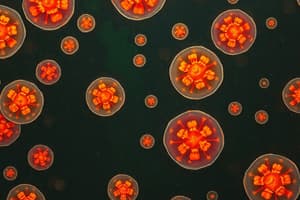Podcast
Questions and Answers
Which type of cells recognize peptide antigens displayed by MHC molecules?
Which type of cells recognize peptide antigens displayed by MHC molecules?
- Macrophages
- T lymphocytes (correct)
- Natural killer cells
- B lymphocytes
What is the physiological role of MHC molecules?
What is the physiological role of MHC molecules?
- To display peptides derived from microbial protein antigens to antigen-specific T lymphocytes (correct)
- To reject tissue grafts exchanged between individuals
- To produce microbial protein antigens
- To perform natural biological phenomenon
Which individuals are likely to accept grafts from each other?
Which individuals are likely to accept grafts from each other?
- Individuals who are not identical at their MHC locus
- Identical twins (correct)
- Inbred animals
- Individuals who differ at their MHC loci
Which of the following is true regarding human leukocyte antigens (HLAs)?
Which of the following is true regarding human leukocyte antigens (HLAs)?
What do the class I and class II MHC genes encode?
What do the class I and class II MHC genes encode?
What is the meaning of polymorphism in the context of MHC genes?
What is the meaning of polymorphism in the context of MHC genes?
Which domains of the alpha chain in class I MHC molecules contain polymorphic residues?
Which domains of the alpha chain in class I MHC molecules contain polymorphic residues?
What is the function of the CD8 T cell coreceptor in class I MHC molecules?
What is the function of the CD8 T cell coreceptor in class I MHC molecules?
What is the typical length of peptides that can be accommodated in the peptide-binding cleft of class I MHC molecules?
What is the typical length of peptides that can be accommodated in the peptide-binding cleft of class I MHC molecules?
What is the function of the CD8 coreceptor in T cell activation?
What is the function of the CD8 coreceptor in T cell activation?
What is the difference between the α1 and α2 domains in class II MHC molecules?
What is the difference between the α1 and α2 domains in class II MHC molecules?
What is the role of the β2-microglobulin in MHC molecules?
What is the role of the β2-microglobulin in MHC molecules?
Flashcards are hidden until you start studying
Study Notes
Antigen Recognition and MHC Molecules
- CD8+ T cells recognize peptide antigens displayed by MHC class I molecules
- MHC molecules play a physiological role in presenting antigens to T-cells for recognition and response
MHC and Graft Acceptance
- Identical twins are likely to accept grafts from each other due to their identical MHC makeup
Human Leukocyte Antigens (HLAs)
- HLA genes are highly polymorphic, with many alleles, causing different individuals to have distinct HLA types
- HLA genes are responsible for encoding MHC molecules
MHC Genes and Proteins
- Class I MHC genes encode proteins that present endogenous antigens to CD8+ T cells
- Class II MHC genes encode proteins that present exogenous antigens to CD4+ T cells
- The polymorphism of MHC genes refers to the high degree of genetic variation between individuals
Class I MHC Structure and Function
- The alpha 1 and alpha 2 domains of class I MHC molecules contain polymorphic residues
- The CD8 T cell coreceptor binds to the alpha 3 domain of class I MHC molecules
- The peptide-binding cleft of class I MHC molecules can accommodate peptides typically 8-11 amino acids in length
- The CD8 coreceptor functions to stabilize the interaction between the T cell receptor and the MHC-peptide complex during T cell activation
Class II MHC Structure and Function
- The α1 and α2 domains of class II MHC molecules are involved in peptide binding
- The β2-microglobulin is a protein that associates with the α chain of class I MHC molecules to form a functional complex
Studying That Suits You
Use AI to generate personalized quizzes and flashcards to suit your learning preferences.




